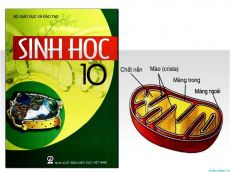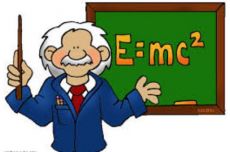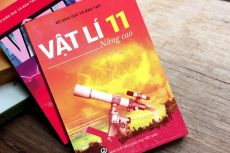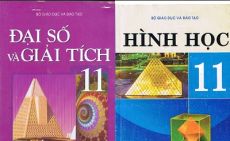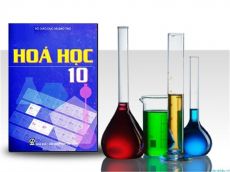Each sentence has a mistake. Find it by chosing A B C or D
Farming now use 10 percent of the earth’s land to produce food
Suy nghĩ và trả lời câu hỏi trước khi xem đáp án
Lời giải:
Báo saiĐáp án A
Farming (việc đồng áng) -> Farmers (nông dân);
dùng N số nhiều vì câu có tính khái quát;
việc sử dụng đất là hoạt động của con người
Câu hỏi liên quan
-
Read the following passage and choose the best answer (A, B, C, D):
Leonardo da Vinci was born on April 15, 1452, in the small Tuscan town of Vinci, near Florence. Leonardo was the son of a wealthy Florentine public official and a peasant woman. In the mid- 1460s, the family settled in Florence, where Leonardo was given the best education that Florence could offer. He rapidly advanced socially and intellectually. He was handsome, persuasive in conversation and a fine musician and improviser. About in 1466, he apprenticed as a studio boy to Andrea Del Verrocchio. In Verrocchio’s workshop, Leonardo was introduced to many activities, from the painting of altarpieces and panel pictures to the creation of large sculptural projects. In 1472, he was entered in the painter’s guild of Florence, and in 1476, he was still mentioned as Verrocchio’s assistant. In Verrocchio’s Baptism of Christ, the kneeling angel at the left of the painting is by Leonardo. In 1478, Leonardo became an independent master. His first commission, to paint an altarpiece for the chapel of the Palazzo Vecchino, the Florentine town hall, was never executed. His first large painting, The Adoration of the Magi, left unfinished, was ordered in 1481 for the Monastery of San Donato a Scopeto, Florence. Other works ascribed to his youth are the so-called Benois Madonna, the portrait Ginerva de’ Benci, and the unfinished Saint Jerome. In 1482, Leonardo’s career moved into high gear when he entered the service of the duke of Milan, Ludovico Sforza, having written the duke an astonishing letter in which he stated that he could build portable bridges; that he knew the techniques of constructing bombardments and of making cannons; that he could build ships as well as armored vehicles, catapults, and other war machines; and that he could execute sculpture in marble, bronze, and clay. He served as a principal engineer in the duke’s numerous military enterprises and was so active also as an architect. In addition, he assisted the Italian mathematician Luca Pacioli in the celebrated work Divina Proportione. Evidence indicates that Leonardo had apprentices and pupils in Milan, for whom he probably wrote the various texts later compiled as Treatise on Painting. The most important of his own paintings during the early Milan period was The Virgin of the Rocks, two versions of which exist; he worked on the compositions for a long time, as was his custom, seemingly unwilling to finish what he had begun. From 1495 to 1496, Leonardo labored on his masterpiece, The Last Super, a mural in the refectory of the Monastery of Santa Maria Delle Grazie, Milan. Unfortunately, his experimental use of oil on dry plaster was technically unsound, and by 1500 its deterioration had begun. Since 1726 attempts have been made, unsuccessfully, to restore it; a concerted restoration and conservation program, making use of the latest technology, was begun in 1977 and is reversing some of the damage. Although much of the original surface is gone, the majesty of the composition and the penetrating characterization of the figures give a fleeting vision of its vanished splendor. During his long stay in Milan, Leonardo also produced other paintings and drawings, most of which have been lost theater designs, architectural drawings, and models for the dome of Milan Cathedral. His largest commission was for a colossal bronze monument to Francesco Sforza, father of Ludovico, in the courtyard of Castello Sforzesco. In December 1499, however, the Sforza family was driven from Milan by French forces; Leonardo left the statue unfinished and he returned to Florence in 1500.
1. The pronoun “he” in paragraph 3 refers to __________ -
Read the following passage and choose the best answer (A, B, C, D):
Until the twentieth century cigarettes were not an important threat to public health. Men used tobacco mainly in the form of cigars. They chewed tobacco, piped tobacco, and snuffed. Most women did not use tobacco at all. The cigarette industry began in 1870s with the development of the cigarette manufacturing machine. This made it possible to produce great numbers of cigarettes very quickly, and it reduced the price. Today cigarette smoking is a widespread habit. About forty-three percent of the adult men and thirty-one percent of the adult women in the United States smoke cigarettes regularly. It is encouraging to note, however, that millions of people have quits smoking. Seventy-five percent of the male population and forty-six percent of the female population have smoked cigarettes for some time during their lives, but twenty-six percent of these men and eleven percent of women have stopped smoking. The number of persons who have given up smoking is increasing. Men as a group smoke more than women. Among both men and women the age group with the highest proportion of smokers is the age group 24-44. Income, education, and occupation all play a part in determining a person’s smoking habit. City people smoke more than people living on farms. Well-educated men with high incomes are less likely to smoke cigarettes than men with fewer years of schooling and lower incomes. On the other hand, if a well-educated man with a higher income smokes, he’s likely to smoke more packs of cigarettes per day. The situation is somewhat different for women. There are slightly more smokers among women with higher family incomes and higher education than among the lower income and lower educational groups. These more highly educated women tend to smoke more heavily. Among teenagers the picture is similar. There are fewer teenager smokers from upper-income, well-educated families, and also fewer from families living in farm areas. High school students who are preparing for college are less likely to smoke than those who don’t plan to continue their education after high school. Children are most likely to start smoking if one or both of their parents smoke
6. The underlined word “picture” in the last paragraph probably means ______________ -
Choose the best answer:
So many students have passed the test. -
Choose the word or phrase A, B, C or D that best fits the blank space in the following passage:
"Face-to-face conversation is a two-way process: you speak to me, I reply to you and so on. Two-way (1)….. depends on having a coding System that is understood by both (2)….. and receiver, and an agreed convention about (3)…. the beginning and end of the (4)… . In speech, the coding System is the language like English or Spanish; the convention that one person speaks at a time may seem too obvious to (5)…. . In fact, the (6)…..that people use in conversations and meetings are often non- verbal. For example, lowering the pitch of voice may mean the end of a sentence; a Sharp intake of breath may signal the desire to (7)….. , catching the chairman’s (8)…. may indicate the desire to speak in a formal setting like a (9)….. , a clenched fist may indicate anger. When these (10)….. signals are not possible, more formal signals may be needed."
9. in a formal setting like a (9)….. , a clenched fist may indicate anger.
-
Read the following passage and choose the best answer (A, B, C, D):
It is natural for young people to be critical of their parents at times and to blame them for most of the misunderstandings between them. They have always complained, more or less justly, that their parents are out of touch with modern ways; that they are possessive and dominant; that they do not trust their children to deal with crises; that they talk too much about certain problems, and that they have no sense of humor, at least in parent-child relationships. I think it is true that parents often underestimate their teenage children and also forget how they themselves felt when they were young. Young people often irritate their parents with their choices in clothes and hairstyles, in entertainers and music. This is not their motive. They feel cut off from the adult world into which they have not yet been accepted. So they create a culture and society of their own. Then, if it turns out that their music or entertainers of vocabulary or clothes or hairstyles irritate their parents, this gives them additional enjoyment. They feel they are superior, at least in a small way, and that they are leaders in style and taste. Sometimes you are resistant and proud because you do not want your parents to approve of what you do. If they approve, it looks as if you are betraying your own age group. But in that case, you are assuming that you are the underdog; you cannot win; but at least you keep your honor. This is a passive way of looking at things. It is natural enough after long years of childhood, when you were completely under your parents’ control. But it ignores the fact that you are now beginning to be responsible for yourself. If you plan to control your life, cooperation can be part of that plan. You can charm others, especially your parents, into doing things the way you want. You can impress others with your sense of responsibility and initiative, so that they will give you the authority to do what you want to do.
1. The author of the passage is primarily addressing __________ -
Rewrite the sentence:
He said that he would take responsibility for his company's damage to the area. But then he denied that. -
Read the following passage and choose the best answer (A, B, C, D)
Amy Johnson was born in 1903 and grew up in Hull, England. The pioneering British aviator is one of the inspiring female figurehead of the 20th century. After university, Amy got a badly-paid (1)_____managed to save enough money to take flying lessons. She went on to qualify as a pilot, (2)___ receiving her license in 1929. In 1930, (3)_______only flown for seventy-five hours, she persuaded a rich businessperson to give her money to buy a plane, and set off alone for Darwin, Australia, in the hope of breaking the record for flying solo from England to Australia in fourteen days. Amy was the first woman to make this flight, (4) _______ took her nineteen days. She failed to breathe record, but was welcomed home as a hero. Over the next ten years, Amy made many record-breaking flights. During these years, she was admired for her skill and courage, and she is still fondly remembered as Britain’s first “Queen of the Air”. She is also remembered in many ways, one of which is the British Women Pilot’s Association award - a scholarship to help outstanding women pilots (5)______their careers -
Read the following passage and choose the best answer (A, B, C, D):
The Greenbox emerged as Ireland’s first and most successful integrated ecotourism destination with a set of standards based on sound environmental practices highlighting all (1) ____ the region and its people had to offer. The Greenbox aimed to deliver environmentally sustainable tourism products, accommodation and attractions. Such tourism activity would have minimal impact (2) ____ the ecology of the area, be of maximum benefit to the local communities and (3) ____ the needs of the environmentally conscious visitor. The Greenbox encompassed an area covering all of Leitrim and Fermanagh and parts of Donegal, Sligo and Cavan. The Greenbox promoted travel which is small scale, low impact, culturally sensitive and community orientated, and provided a marketing tool for businesses that were grounded in sustainable principles and (4) ____ within the Greenbox area. The concept was broader than (5) ____ established definition of tourism, embracing activities such as organic food production, rural transport, energy and waste management -
Read the following passage and choose the best answer (A, B, C, D):
With 13,000 floral species and over 15,000 faunal species, three newly discovered big animal species, and a ratio of country/world species of 6.3%. Vietnam has enormous tourismparticularly ecotourism-potential. In fact, since 1986, when Renovation Reforms began the shift from a centrally planned to a socialist-oriented market, or multi-sectoral, economy, tourism has been an sector of primary concern to the government. In May 1995, the prime minister of Vietnam approved a master plan of tourism development for the period 1995- 2010. In February 1999, the state decree on tourism was part of the socio-economic development strategy for the period 2001-2010 approved at the IX National Congress of the Party: “Tourism development has become a spearhead economic industry indeed. It is necessary to improve the quality and effectiveness of tourism activities, bringing into full play the natural conditions, and cultural and historical tradition to meet the domestic and international demand for tourism and to catch up with tourism development in the region” (Document of the IX National Congress 2001). Tourism has so far brought great benefits to the economy, but it has also contributed to environmental degradation, especially biodiversity deterioration. Thus, the concept of “sustainable development”-development which meets the needs of the present without compromising the ability of future generations to meet their own needs - must be factored into tourism development. This consideration is reflected in the term “ecotourism,” which is referred to variously as ecological or environmental tourism, nature or green tourism, sustainable or responsible tourism. Ecotourism involves travel to relatively undisturbed natural areas with the specific object of studying, admiring, and enjoying scenery, plants, and animals, as well as any cultural features found in these areas. It is distinguished from mass or resort tourism by its lower impact on the environment, lower infrastructure requirements, and its role in educating tourists about natural environments and cultural values. Fully aware of its significance, the government of Vietnam has prioritized ecotourism in its strategy for tourism development to ensure both sustainability and economic benefits. Though ecotourism in Vietnam is at a beginning stage of development, it is expected to grow strongly through support from government and international organizations.
2. When has tourism officially contributed to socio-economic development? -
Read the following passage and choose the best answer (A, B, C, D)
Andrew Jackson Beard lived an extraordinary life for a black American inventor. Unlike the vast majority of inventors who never profit from their patents, he profited from his inventions. Andrew Beard was born a slave on a plantation in Woodland, Alabama, in 1849, shortly before slavery ended. He received emancipation at age 15 and he married at age 16. Andrew Beard was a farmer, carpenter, blacksmith, a railroad worker, a businessman and finally an inventor. He grew apples as a farmer near Birmingham, Alabama for five years before he built and operated a flour mill in Hardwicks, Alabama. His work in agriculture led to tinkering with improvement for plows. In 1881, he patented his first invention, an improvement to the double plow, and sold the patent rights for $4,000 in 1884. His design allowed for the distance between the plow plates to be adjusted. That amount of money would be the equivalent of almost $100,000 today. In 1887, Andrew Beard patented a second plow and sold it for $5,200. This patent was for a design that allowed the pitch of the blades of plows or cultivators to be adjusted. The amount he received would be the equivalent of about $130,000 today. In 1897, Andrew Beard patented an improvement to railroad car couplers. His improvement came to be called the Jenny Coupler. It was one of many that aimed to improve the knuckle coupler patented by Eli Janney in 1873 (patent US138405). The knuckle coupler did the dangerous job of hooking railroad cars together, which formerly was done by manually placing a pin in a link between the two cars. Beard, himself had lost a leg in a car coupling accident. As an ex-railroad worker, Andrew Beard had the right idea that probably saved countless lives and limbs. Beard received three patents for automatic car couplers. These are US594059 granted November 23, 1897, US624901 granted May 16, 1899, and US807430 granted on May 16, 1904. While there were thousands of patents filed at the time for car couplers, Andrew Beard received $50,000 for the patent rights to his Jenny coupler. This would be just shy of 1.5 million dollars today. Congress enacted the Federal Safety Appliance Act at that time to enforce using automatic couplers. Andrew Jackson Beard was inducted into the National
Inventors Hall of Fame in 2006 in recognition of his revolutionary Jenny coupler
5. According to paragraph 3, which is one of the patent years of Beard’s modified couplers? -
Read the following passage and choose the best answer (A, B, C, D):
The fresh data released by the Centre for Monitoring Indian Economy (CMIE) showed that unemployment rate in the month of October jumped to 8.5 per cent, which is the highest in over three years. A new academic research paper released by the Centre of Sustainable Employment also concluded that there has been a marked decline in total employment in India between 2011-12 and 2017-18, reported The Indian Express. The research paper by Santosh Mehrotra and Jaiati K Parida stated as, "However, due to sharp increases in enrollment at every level of education over the noughties, it was expected that post -2012 total employment would increase, particularly in the non-farm sectors. But unfortunately, total employment during 2011-12 and 2017-18 declined by 9 million. The research further states that this happened for the first time in India’s history. It is really ironical noting that Coimbatore Municipal Corporation posted a vacancy for 549 sanitary workers. What followed was that 7000 highly qualified applicants even some of them with engineering and graduate degrees applied for the job. The Corporation witnessed the overwhelming turnout of 7000 candidates. Similarly, few month back, Chennai witnessed an unusual event when around 4600 of youth sent their application for 14 posts like sweepers and sanitary workers. The applicants had professional qualification like B.Tech, M.Tech, Master of Business Administration. Though the government constantly has been refuting the grim of job data but the facts and figures can’t be avoided any more. Therefore, now the government should take an initiative to overcome the high prevalence of unemployment and figure out the derivers of the job crisis. In this regard, it is worth to mention a book titled ‘Job crisis in India’ written by business journalist Raghavan Jagnnathan. The author in his book pointed out factors and reasons behind this decline of employment. He attributed that the absence of skills required in the highly technical nature of jobs is big factor. Another aspect of this is that in the majority of cases the skills or training acquired by the youths do not match or suit the core demand of the job. So at first the government must step up for reformation, innovation and renovation of the standard of the education in universities and colleges.
7. Which of the following statements is TRUE, according to the passage? -
Read the following passage and choose the best answer (A, B, C, D):
The International Monetary Fund (IMF) is an organization of 189 member countries. It stabilizes the global economy in three ways. First, it monitors global conditions and identifies risks. Second, it advises its members on how to improve their economies. Third, it provides technical assistance and short-term loans to prevent financial crises. The IMF’s goal is to prevent these disasters by guiding its members. These countries are willing to give up some of their sovereign authority to achieve that aim. The IMF has the rare ability to look into and review the economies of all its member countries. As a result, it has its finger on the pulse of the global economy better than any other organization. The IMF produces a wealth of analytical reports. It provides the World Economic Outlook, the Global Financial Stability Report, and the Fiscal Monitor each year. It also delves into regional and country-specific assessments. It uses this information to determine which countries need to improve their policies. Hence, the IMF can identify which countries threaten global stability. The member countries have agreed to listen to the IMF’s recommendations because they want to improve their economies and remove these threats. Since the Mexican peso crisis of 1994–95 and the Asian crisis of 1997–98, the IMF has taken a more active role to help countries prevent financial crises. It develops standards that its members should follow. For example, members agree to provide adequate foreign exchange reserves in good times. That helps them increase spending to boost their economies during recessions. The IMF reports on members countries’ observance of these standards. It also issues member country reports that investors use to make well-informed decisions. That improves the functioning of financial markets. The IMF also encourages sustained growth and high living standards, which is the best way to reduce members’ vulnerability to crises. The IMF provides loans to help its members tackle balance of payments problems, stabilize their economies, and restore sustainable growth. Because the Fund lends money, it’s often confused with the World Bank. The World Bank lends money to developing countries for specific projects that will fight poverty. Unlike the World Bank and other development agencies, the IMF does not finance projects. Traditionally, most IMF borrowers were developing countries. They had limited access to international capital markets due to their economic difficulties. An IMF loan signals that a country’s economic policies are on the right track. That reassures investors and acts as a catalyst for attracting funds from other sources. All that shifted in 2010 when the Eurozone crisis prompted the IMF to provide short-term loans to bail out Greece. That was within the IMF’s charter because it prevented a global economic crisis. The role of the IMF has increased since the onset of the 2008 global financial crisis. In fact, an IMF surveillance report warned about the economic crisis but was ignored. As a result, the IMF has been called upon more and more to provide global economic surveillance. It’s in the best position to do so because it requires members to subject their economic policies to IMF scrutiny. Member countries are also committed to pursuing policies that are conducive to reasonable price stability, and they agree to avoid manipulating exchange rates for unfair competitive advantage.
7. Which of the following best summarizes paragraph 4? -
Read the following passage and choose the best answer (A, B, C, D):
Previously, people often only considered second-hand smoke as a welfare issue, focusing on the smell and the irritation that tobacco smoke causes to eyes, nose and throat. But now the weight of evidence for much more serious risks to health from second-hand smoke has grown too great to ignore. Tobacco smoke contains around 4,000 chemicals, including arsenic, benzene, formaldehyde and ammonia. Around 60 of these chemicals are known or suspected to cause cancer. Many of the toxic chemicals are actually more concentrated in the smoke that’s given off by the burning tip of a cigarette (sidestream smoke). Around 85 per cent of the smoke in a room where people are smoking is the more toxic sidestream smoke. By breathing in it in the atmosphere, the non-smoker is exposed to many of the same health risks as the smoker. The best known risk to smokers, lung cancer, is also more common in people regularly exposed to second-hand smoke. The Government’s Scientific Committee on Tobacco and Health (SCOTH) reported in 1998 that exposure to second-hand smoke increases the risk of lung cancer in non-smokers by 20-30 per cent. Even though they inhale only 1% of the smoke, non-smokers exposed to second-hand smoke may suffer 25 per cent of the increased risk of heart disease associated with active smoking (one recent study suggests it might be as much as 50 per cent). Just 30 minutes of breathing second-hand smoke can reduce the coronary blood supply of a non-smoker to the same level as that of a smoker. A study in New Zealand found that exposure to second-hand smoke increases the risk of stroke by 82 per cent in non-smokers. This is a serious concern, as stroke is such a common condition. Moreover, around 3.4 million people in the UK have asthma and for most of these, tobacco smoke is a trigger for an asthma attack. For someone with asthma, just one hour of exposure to second-hand smoke can cause a 20 per cent deterioration in lung function. During pregnancy, breathing in second-hand smoke increases the risk of having a baby with a low birth weight. Small babies are at much greater risk of infections and other health problems. A recent review of international research on the immediate health impact of smokefree workplace legislation found rapid and dramatic improvements. Air quality, respiratory health and levels of heart attacks and heart disease all improved substantially within months of the legislation being introduced.
8. The highlighted word "immediate" in the passage is closest in meaning to ________ -
Read the following passage and mark the letter A, B, C, or D on your answer sheet to indicate the correct answer to each of the questions from 36 to 42.
It is estimated that by 2050 more than two-thirds of the world's population will live in cities, up from about 54 percent today. While the many benefits of organized and efficient cities are well understood, we need to recognize that this rapid, often unplanned urbanization brings risks of profound social instability, risks to critical infrastructure, potential water crises and the potential for devastating spread of disease. These risks can only be further exacerbated as this unprecedented transition from rural to urban areas continues.
How effectively these risks can be addressed will increasingly be determined by how well cities are governed. The increased concentration of people, physical assets, infrastructure and economic activities mean that the risks materializing at the city level will have far greater potential to disrupt society than ever before.
Urbanization is by no means bad by itself. It brings important benefits for economic, cultural and societal development. Well managed cities are both efficient and effective, enabling economies of scale and network effects while reducing the impact on the climate of transportation. As such, an urban model can make economic activity more environmentally-friendly. Further, the proximity and diversity of people can spark innovation and create employment as exchanging ideas breeds new ideas.
But these utopian concepts are threatened by some of the factors driving rapid urbanization. For example, one of the main factors is rural-urban migration, driven by the prospect of greater employment opportunities and the hope of a better life in cities. But rapidly increasing population density can create severe problems, especially if planning efforts are not sufficient to cope with the influx of new inhabitants. The result may, in extreme cases, be widespread poverty. Estimates suggest that 40% of the world's urban expansion is taking place in slums, exacerbating socio-economic disparities and creating unsanitary conditions that facilitate the spread of disease.
The Global Risks 2015 Report looks at four areas that face particularly daunting challenges in the face of rapid and unplanned urbanization: infrastructure, health, climate change, and social instability. In each of these areas we find new risks that can best be managed or, in some cases, transferred through the mechanism of insurance.Which statement is TRUE, according to the passage?
-
Read the following passage and choose the best answer (A, B, C, D):
Culture has a strong influence on non–verbal communication. Even the simple act of looking someone in the eye is not at all that simple. In the USA, Americans are (1) ______ to look directly at people when speaking to them. It shows interest in what they are saying and is thought to carry a (2) ______ of honesty. Meanwhile, in Japan and Korea, people avoid long periods of eye contact. It is considered more polite to look to the side during a conversation. The Lebanese, (3) ______, stand close together and look intensely into each other's eyes. The action shows sincerity and gives people a better sense of what their counterparts want. Given such differences with even the most common expressions, people (4) ______ travel or work abroad have a real need to learn the other culture's body language. People tend to be unaware of the messages they are sending to others. So, it is (5) ______ to consider your own body language before dealing with people from other cultures. Knowing about the body language of friends, clients, and colleagues can be very helpful in improving understanding and avoiding miscommunication. -
Read the following passage and mark the letter A, B, C, or D on your answer sheet to indicate the correct answer to each of the following questions:
Foot racing is a popular activity in the United States. It is seen not only as a competitive sport but also as a way to exercise, to enjoy the camaraderie of like-minded people, and to donate money to a good cause. Though serious runners may spend months training to compete, other runners and walkers might not train at all. Those not competing to win might run in an effort to beat their own time or simply to enjoy the fun and exercise. People of all ages, from those of less than one year (who may be pushed in strollers) to those in their eighties, enter into this sport. The races are held on city streets, on college campuses, through parks, and in suburban areas, and they are commonly 5 to 10 kilometers in length.
The largest foot race in the world is the 12-kilometer Bay to Breakers race that is held in San Francisco every spring. This race begins on the east side of the city near San Francisco Bay and ends on the west side at the Pacific Ocean. There may be 80,000 or more people running in this race through the streets and hills of San Francisco. In the front are the serious runners who compete to win and who might finish in as little as 34 minutes. Behind them are the thousands who take several hours to finish. In the back of the race are those who dress in costumes and come just for fun. One year there was a group of men who dressed like Elvis Presley, and another group consisted of firefighters who were tied together in a long line and who were carrying a fire hose. There was even a bridal party, in which the bride was dressed in a long white gown and the groom wore a tuxedo. The bride and groom threw flowers to bystanders, and they were actually married at some point along the route.The word “it” in the first paragraph refers to .
-
Mark the letter A, B, C, or D on your answer sheet to indicate the undelined part that needs correction in each of the following questions:
One of the highest honors for formalists, writers, and musical composers is the PulitzerPrize. First awarded in 1927, the Pulitzer Prize has been won by Ernest Hemingway, Harper Lee,John F. Kennedy, and Rodgers and Hammerstein, among others. As with many famous awards,this prize was named after its founder, Joseph Pulitzer.
Joseph Pulitzer’s story, like that of many immigrants to the United States, is one ofhardship, hard work and triumph. Born in Hungary, Joseph Pulitzer moved to United States in1864. He wanted to be a reporter, but he started his American life by fighting in the AmericanCivil War. After the war, Pulitzer worked for the German - language newspaper, the WestlichePost. His skills as a reporter were wonderful, and he soon became a partial owner of the paper.
In 1978, Pulitzer was able to start a newspaper of his own. Right from the first edition,the newspaper took a controversial approach to new. Pulitzer wanted to appeal to the averagereader, so he produced exciting stories of scandal and intrigue. Such an approach iscommonplace today, but in Pulitzer’s time it was new and different. The approach led to thediscovery of many instances of corruption by influential people. Pulitzer ‘paper became veryfamous and is still produced today.
The success of Joseph Pulitzer’s newspaper made him a very wealthy man, so he wantedto give something back to his profession. Throughout his later years, he worked to establishuniversity programs for the teaching of journalism, and he funded numerous scholarships toassist journalism students. Finally, he wanted to leave a legacy that would encourage writers toremember the importance of quality. On his death, he gave two million dollars to ColumbiaUniversity so they could award prizes to great writers
The Pulitzer Prize recipients are a very select group. For most, winning a Pulitzer Prize isthe highlight of their career. If an author, journalist, or composer you know has won a PulitzerPrize, you can be sure they are at the top of their profession.The word “partial" in the passage is closest in meaning to......
-
Each sentence has a mistake. Findit by chosing A B C or D
One of the most beautiful botanical gardens in the United States is the wildly and lovely Magnolia Gardens near Charleston, South Carlifornia
-
Read the following passage and choose the best answer (A, B, C, D):
An American game that has traveled well is basketball, now played by more than 250 million people worldwide in an organized fashion, as well as by countless others in “pick-up” games. Basketball originated in 1891 when a future Presbyterian minister named James Naismith (1861-1939) was assigned to teach a physical education class at a Young Men’s Christian Association (YMCA) training school in Springfield, Massachusetts. The class had been noted for being disorderly, and Naismith was told to invent a new game to keep the young men occupied. Since it was winter and very cold outside, a game that could be played indoors was desirable. Naismith thought back to his boyhood in Canada, where he and his friends had played “duck on a rock,” which involved trying to knock a large rock off a boulder by throwing smaller rocks at it. He also recalled watching rugby players toss a ball into a box in a gymnasium. He had the idea of nailing up raised boxes into which players would attempt to throw a ball. When boxes couldn’t be found, he used peach baskets. According to Alexander Wolff, in his book 100 Years of Hoops, Naismith drew up the rules for the new game in “about an hour.” Most of them still apply in some forms today. Basketball caught on because graduates of the YMCA school traveled widely, because Naismith disseminated the rules freely, and because there was a need for a simple game that could be played indoors during winter. Naismith’s legacy included the first great college basketball coach, Forrest “Phog” Allen (1885-1974), who played for Naismith at the University of Kansas and went on to win 771 games as a coach at Kansas himself. Among Allen’s star players was Wilt Chamberlain, who became one of professional basketball’s first superstars – one night in 1962, he scored a record 100 points in a game. The first professional basketball league was formed in 1898; players earned $2.50 for home games, $1.25 for games on the road. Not quite 100 years later, Juwan Howard, a star player for the Washington Bullets (now called the Washington Wizards), had competing offers of more than $100 million over seven seasons from the Bullets and the Miami Heat. Many teams in the National Basketball Association now have foreign players, who return home to represent their native countries during the Olympic Games. The so-called Dream Team, made up of the top American professional basketball players, has represented
the United States in recent Olympic Games. In 1996 the Dream Team trailed some opponents until fairly late in the games. In Athens in 2004 Argentina took home the gold, the first time a Latin American country won the basketball honor.
6. The word “disseminated” in paragraph 3 can be best replaced by ______ -
Read the following passage and choose the best answer (A, B, C, D):
Nature photographer Joel Sartore is passionate about endangered species. He uses his camera to make people aware of environmental problems. They tell the stories of animals that may disappear unless we work fast to save them. Sartore’s latest project is called Photo Ark. The goal of the project is to make a photographic record of the world’s biodiversity. As Sartore says, “For many of Earth’s creatures, time is running out.” When asked how he became interested in saving endangered species, Joel said “When I was a child, I read about Martha, the very last passenger pigeon. Martha died in 1914. I was shocked. In the past, there were 5 billion passenger pigeons – probably more than any other bird. But here was the last one, and there was no way to save it. How did we let this happen? I couldn’t understand it. I still feel the same way. I want to prevent this from ever happening again.” Photography is the best way to show problems to the world. It gets people to care about the problem. It’s not enough to just show pretty animals in a beautiful landscape. Now, we must show the threats to these animals as well. The good news is that there are many ways to publish stories and photographs on environmental issues. Self-publishing on the Web is one way to do this. Even nonprofessional photographers can help to make us aware of these problems
5. The last paragraph discusses _________

